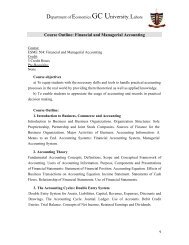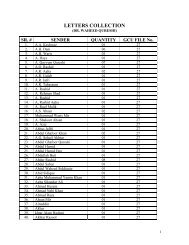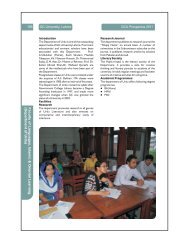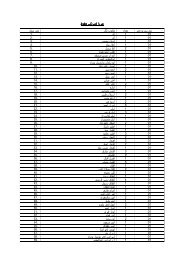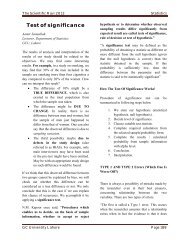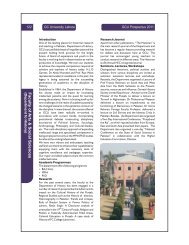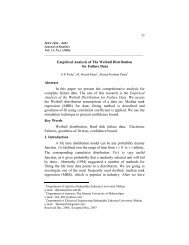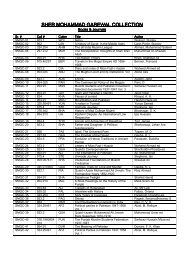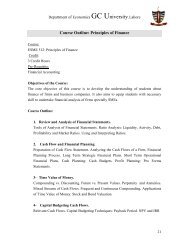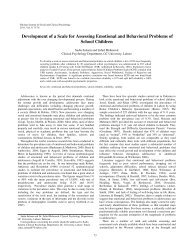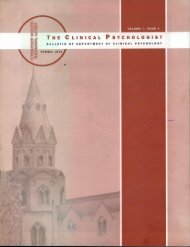Numerical Methods for Bayesian Analysis - Government College ...
Numerical Methods for Bayesian Analysis - Government College ...
Numerical Methods for Bayesian Analysis - Government College ...
Create successful ePaper yourself
Turn your PDF publications into a flip-book with our unique Google optimized e-Paper software.
ISSN 1684-8403<br />
Journal of Statistics<br />
Volume 19, 2012. pp. 83-90<br />
________________________________________________________________________<br />
Abstract<br />
<strong>Numerical</strong> <strong>Methods</strong> <strong>for</strong> <strong>Bayesian</strong> <strong>Analysis</strong><br />
Nasir Abbas 1 , Syed Mohsin Ali Kazmi 2 and Muhammad Aslam 3<br />
<strong>Bayesian</strong> Inference is a technique of statistical inference that, in addition to using<br />
the sample in<strong>for</strong>mation, utilizes prior in<strong>for</strong>mation about Parameter(s) to draw<br />
results about the Parameters. But the beauty is subdued by huge and cumbersome<br />
algebraic calculations necessary to find Posterior estimates. This article suggests<br />
numerical methods to derive Posterior distributions under all types of priors –<br />
unin<strong>for</strong>mative and in<strong>for</strong>mative – and to find Bayes Estimates. We use both<br />
numerical differentiation and numerical integration to serve the purpose. The<br />
entire estimation procedure is illustrated using real as well as simulated datasets.<br />
Keywords<br />
<strong>Numerical</strong> differentiation, <strong>Numerical</strong> integration, Fisher's in<strong>for</strong>mation, Jeffreys<br />
prior, Squared error loss function (SELF), Bayes estimator, Exponential<br />
distribution, Normal distribution<br />
1. Introduction<br />
The main difference between the <strong>Bayesian</strong> and the Frequentistic schools<br />
of thoughts is that the <strong>for</strong>mer associate randomness with population Parameters<br />
and <strong>for</strong>mally incorporate in their analysis any prior in<strong>for</strong>mation pertaining to<br />
Parameters. Prior in<strong>for</strong>mation about Parameters is updated with current<br />
in<strong>for</strong>mation (data) to yield Posterior Distribution, which is a work-bench <strong>for</strong> the<br />
<strong>Bayesian</strong>s. Adams (2005) throws light on the advantages of using <strong>Bayesian</strong><br />
approach. But the major problem, which <strong>Bayesian</strong>s face, is the calculation of<br />
Posterior Estimates via the Posterior Distribution.<br />
________________________________________<br />
1<br />
Department of Statistics, <strong>Government</strong> Postgraduate <strong>College</strong>, Jhang, Pakistan.<br />
Email: nabbasgcj@yahoo.com<br />
2<br />
Sustainable Development Policy Institute, Islamabad, Pakistan.<br />
3<br />
Department of Statistics, Quaid-i-Azam University, Islamabad, Pakistan.
84<br />
Nasir Abbas, Syed Mohsin Ali Kazmi and Muhammad Aslam<br />
_______________________________________________________________________________<br />
The problem is even aggravated when we use the Jeffreys Prior. It renders the<br />
Posterior Distribution and hence the Posterior Inference even more complicated.<br />
Different numerical techniques, like Gibbs sampler, numerical integration etc. are<br />
used to address these problems. WinBUGS is recently-developed software that is<br />
being extensively used to get the Posterior summaries of Parameters.<br />
In this study, an ef<strong>for</strong>t is made to suggest numerical technique that efficiently<br />
deals with all the problems of Posterior Estimation. It not only gives us the<br />
Posterior Estimates of Parameters but also accommodates the Jeffreys Prior if it is<br />
suggested to be used. The use of other type of priors – unin<strong>for</strong>mative uni<strong>for</strong>m<br />
prior, conjugate prior and other in<strong>for</strong>mative priors – is comparatively easy than<br />
that of the Jeffreys Prior.<br />
The breakup of the study is as follows: In Section 2, the Fisher's in<strong>for</strong>mation and<br />
the Jeffreys Prior are explained along with <strong>for</strong>mulae <strong>for</strong> numerical differentiation.<br />
Section 3 is concerned with the Quadrature method of numerical integration. In<br />
Section 4, the estimation methodology is explained. Section 5 presents illustrative<br />
examples of the entire estimation procedure. We have considered the cases of one<br />
as well as two Parameters by taking into account the Exponential and the Normal<br />
Distributions. Multivariate Distributions may similarly be accounted <strong>for</strong>. Section<br />
6 concludes the entire study and discusses the results.<br />
2. The Jeffreys Prior<br />
The situations where we do not have much in<strong>for</strong>mation about the Parameters of a<br />
model, we use an unin<strong>for</strong>mative prior proposed by Jeffreys (1946, 1961) and is<br />
defined as the density of Parameters proportional to the square root of the<br />
determinant of the Fisher’s in<strong>for</strong>mation matrix. Let the dataset X be drawn from a<br />
certain Distribution ( ) that depends upon the vector of Parameters<br />
( ) The Likelihood Function is denoted by ( ) and its Fisher's<br />
( )<br />
In<strong>for</strong>mation is given by ( ) { }. The Fisher's In<strong>for</strong>mation<br />
measures the sensitivity of an estimator in the neighborhood of the Maximum<br />
Likelihood Estimate (MLE), as it is proportional to the expected curvature of the<br />
Likelihood at the MLE. Jeffreys, more generally, suggests invariance prior<br />
(Berger, 1985) which takes the <strong>for</strong>m<br />
( ) √ * ( )+, where (2.1)
<strong>Numerical</strong> <strong>Methods</strong> <strong>for</strong> <strong>Bayesian</strong> <strong>Analysis</strong><br />
_______________________________________________________________________________<br />
If the nature of expressions involved in the determinant is complicated, we may<br />
use the numerical methods <strong>for</strong> finding the second partial derivatives to calculate<br />
the Jeffreys Prior using the relations<br />
( )<br />
|(<br />
)<br />
( ) ( ) ( )<br />
, (2.2)<br />
85<br />
and<br />
( )<br />
|(<br />
)<br />
( ) ( ) ( ) ( )<br />
, (2.3)<br />
where ( ) is a bi-variate function and denotes the partial double derivative<br />
with regard to the random variable u. For more details, one can see Bernardo<br />
(1979), Berger and Bernardo (1989, 1992a, 1992b), Datta and Ghosh (1995),<br />
Jeffreys (1961).<br />
3. The Quadrature Method<br />
We usually need to evaluate multiple integrals to find Bayes Estimates, <strong>for</strong><br />
example, Posterior means, predictive probabilities, Posterior probabilities <strong>for</strong><br />
Hypotheses testing etc. based on complicated nature of the Posterior Distribution,<br />
particularly when there is a Vector of Parameters and the expressions involve<br />
complicated algebraic functions. Considering a one-dimensional case, the<br />
Quadrature refers to any method <strong>for</strong> numerically approximating the value of the<br />
definite integral ∫ ( ) , where ( ) may be any proper density. The<br />
procedure is to calculate it at a number of points in the range ‘a’ through ‘b’ and<br />
find the result as a weighted average as<br />
∫ ( ) ∑ ( ) (3.1)<br />
where <strong>for</strong> all and<br />
stands <strong>for</strong> the size of increment used to approach ‘b’ from ‘a’. Here it is<br />
important to note that the accuracy and size of the increment are inversely related<br />
to each other. Two-dimensional integrals may be evaluated using the relation<br />
∫ ∫ ( ) ∑ ∑ ( ) (3.2)<br />
where ( ) ( ), <strong>for</strong> all , ( )<br />
( ), <strong>for</strong> all and respectively denote the size of<br />
increments in the Parametric values and , and ( ) symbolizes any<br />
Bivariate Density.
86<br />
Nasir Abbas, Syed Mohsin Ali Kazmi and Muhammad Aslam<br />
_______________________________________________________________________________<br />
4. Estimation Methodology<br />
To find the Bayes Estimates of Posterior Distributions, we proceed as follows:<br />
Use one of the <strong>for</strong>mulae (3.1) or (3.2) <strong>for</strong> Quadrature, and repeat the<br />
calculation process ( ) times if there is only one Parameter to be<br />
estimated. For more Parameters, we use Nested Loops to evaluate<br />
Quadrature. The Loop control variable(s) must be initialized, incremented<br />
and checked <strong>for</strong> the desired number of iterations to reach the terminal<br />
value(s). If the ranges involve infinities, the reasonable numbers may be<br />
used to represent infinite ranges. For this, we may continuously and<br />
gradually expand the limits till the convergence of the Posterior Estimates.<br />
The increment of Loops should be accordingly set to attain the precision<br />
required. The smaller be the value of increment, the greater the precision<br />
would be. The Loop control variables are actually the Parameters to be<br />
estimated.<br />
For an observed sample of size n with values taken from a<br />
certain Distribution ( ) define the Likelihood Function ( ) of the<br />
Distribution of data set (current in<strong>for</strong>mation) of random variable(s) as<br />
( ) ∏ ( ) or logarithm of the Likelihood Function as<br />
( ) ∑ ( ).<br />
Using (2.1), derive the Jeffreys prior as ( ) √ * ( )+ based on the<br />
Fisher's in<strong>for</strong>mation matrix ( ) {<br />
( )<br />
}. The numerical<br />
<br />
differentiation may be carried out using relations (2.2) and/or (2.3). For<br />
simplicity, we may use Kernel Density – a density without normalizing<br />
constant – to derive the Jeffreys Prior, because the Jeffreys Prior is only<br />
the function of Parameters and the normalizing constant too is always<br />
independent of the Parameters of the Distribution. Remember that the<br />
Posterior Distributions are always the Distributions of the population<br />
Parameters considered as random variables.<br />
Obtain the Posterior Distribution of the Parameters of interest by<br />
multiplying the Likelihood Function with the Jeffreys Prior obtained as<br />
( ) ( ) ( ), where k is the normalizing constant defined<br />
by ∫ ( ) ( ) . In case of using the Kernel Density, the<br />
normalizing constant is obtained by integrating out the Parameter(s) on the<br />
entire range(s). The Kernel Density is then divided by the normalizing
<strong>Numerical</strong> <strong>Methods</strong> <strong>for</strong> <strong>Bayesian</strong> <strong>Analysis</strong><br />
_______________________________________________________________________________<br />
constant to get a proper density. In this scenario, the Posterior Distribution<br />
is automatically used to yield the desired Posterior Bayes Estimates.<br />
The entire estimation algorithm may be understood by Figure 1.<br />
87<br />
5. Illustrations<br />
For the purpose of illustration of the entire estimation procedure, we take two<br />
examples: one <strong>for</strong> single-Parameter Density and the other <strong>for</strong> two-Parameter<br />
Density and consider the Exponential and the Normal Distributions respectively.<br />
5.1 One-Parameter Distribution: For a one-Parameter case, <strong>for</strong> instance, we<br />
consider the Exponential Distribution with density ( ) ( )<br />
<strong>for</strong> ; and zero elsewhere. Let an observed sample of size ‘n’ with values<br />
be taken from the Exponential Distribution. The Likelihood<br />
Function is ( ) ( ∑ ) and the logarithm of the Likelihood<br />
( )<br />
Function is ( ) ∑ , which implies<br />
. Since it<br />
does not depend upon x, so we get the Fisher's in<strong>for</strong>mation as ( )<br />
( )<br />
{ } and hence the Jeffreys Prior takes the <strong>for</strong>m ( ) . The<br />
Posterior Distribution follows the Gamma Distribution as<br />
( ) ( ∑ ), i.e., ( ∑ ) with Posterior mean<br />
( )<br />
( ̅) .<br />
∑<br />
For illustration, let the time in minutes required to serve a customer at certain<br />
facility have an Exponential Distribution with unknown Parameter θ. If the<br />
average time required to serving a random sample of 20 customers is observed to<br />
be 3.8 minutes. Obviously, the Posterior Distribution <strong>for</strong> the Parameter θ under<br />
the Jeffreys Prior, as derived in Section 5.1, is the Gamma with Parameters 20 and<br />
20 × 3.8 = 76, i.e., ( ) and the Posterior Bayes estimator under the<br />
Squared-Error Loss Function is ( ̅) , i.e., 0.263158.<br />
Using the numerical estimation criteria explained in Section 4, we run a set of C<br />
codes to get ( ) ( ̅) = 0.263158. Even <strong>for</strong> complex Posterior<br />
Distributions, the numerical estimation criteria give good results.<br />
5.2 Two-Parameter Distribution: Similarly, if we consider the Normal<br />
Distribution with Parameters mean and variance , both unknown, with<br />
density ( ) ⁄ √ * ( ) ⁄ ( ) +, ,
88<br />
Nasir Abbas, Syed Mohsin Ali Kazmi and Muhammad Aslam<br />
_______________________________________________________________________________<br />
<strong>for</strong><br />
; and zero elsewhere. For a sample of size n, the Likelihood<br />
Function is ( ) ( ) * ∑ ( ) + and the logarithm of the<br />
Likelihood Function is ( ) ( ) ∑ ( ) , which implies<br />
( )<br />
,<br />
( )<br />
( )<br />
( ) ( )<br />
( ∑ ) ( ) , and<br />
( ) ∑ ( ) .<br />
The partial double-derivative vanishes under expectation and Fisher's in<strong>for</strong>mation,<br />
there<strong>for</strong>e, takes the <strong>for</strong>m ( ) ( ) . The Jeffreys Prior is derived to be<br />
( ) ( ) <strong>for</strong> . The Joint Posterior Distribution,<br />
( ), takes the <strong>for</strong>m<br />
( ) ( ) ( ) * ∑ ( ) + , <strong>for</strong> . (5.1)<br />
After some algebra, it can be shown that the Posterior Marginal Distribution of<br />
precision follows the Gamma Distribution and the Posterior Conditional<br />
Distribution of follows the Normal Distribution.<br />
For illustration, let an observed sample with 7 values, 20.87, 18.83, 21.36, 17.77,<br />
18.97, 26.66 and 24.24, be taken from the Normal Distribution ( ) with<br />
both the Parameters unknown. The observed mean and variance are found to<br />
be 21.24286 and 10.25492 respectively. We now utilize the estimation criteria of<br />
Section 4 and find the Posterior Estimates of mean and variance by running<br />
C codes. The desired Estimates of mean and variance are found to be<br />
21.2429 and 8.65912 respectively. The difference in variance may be due to the<br />
short size of dataset. This difference becomes negligible <strong>for</strong> datasets of large<br />
sizes.<br />
For the simulated dataset of size 100 from the Normal Distribution with mean 0<br />
and variance 1, we get ∑ 10.266 and ∑ 124.7118 with mean<br />
and variance<br />
. The estimated mean and variance<br />
through the suggested criteria are found to be 0.10266 and 1.23617 respectively<br />
which are fairly close to the theoretical results.
<strong>Numerical</strong> <strong>Methods</strong> <strong>for</strong> <strong>Bayesian</strong> <strong>Analysis</strong><br />
89<br />
_______________________________________________________________________________<br />
6. Concluding Remarks<br />
In this article, an ef<strong>for</strong>t is made to elaborate on the numerical methods to find the<br />
Jeffreys Prior and the Posterior Bayes Estimates. <strong>Numerical</strong> differentiation and<br />
Quadrature are considered to find the Jeffreys Prior and the Posterior Bayes<br />
Estimates. For instance of a one-Parameter case, we used the Exponential<br />
Distribution to derive the Jeffreys Prior and the Posterior Estimates, whereas <strong>for</strong><br />
the two-Parameter case, we used the Normal Distribution. The observed and<br />
simulated datasets are studied. It is seen that the theoretical and numerical results<br />
fairly agree.<br />
The same procedure can easily be employed <strong>for</strong> the case of unin<strong>for</strong>mative<br />
uni<strong>for</strong>m, in<strong>for</strong>mative and conjugate priors too. The method works equally well<br />
when priors and datasets are assumed to follow non regular density functions. The<br />
complicated Posterior Distributions can also be handled with equal ease and<br />
accuracy.<br />
Figure 1: The numerical-estimation procedure
90<br />
Nasir Abbas, Syed Mohsin Ali Kazmi and Muhammad Aslam<br />
_______________________________________________________________________________<br />
References<br />
1. Adams, E. S. (2005). <strong>Bayesian</strong> <strong>Analysis</strong> of linear dominance hierarchies.<br />
Animal Behaviour, 69, 1191-1201.<br />
2. Berger, J. O. (1985). Statistical Decision Theory and <strong>Bayesian</strong> <strong>Analysis</strong>. 2nd<br />
Edition. Springer-Verlag, Inc. New York.<br />
3. Berger, J. O. and Bernardo, J. M. (1989). Estimating a product of means:<br />
<strong>Bayesian</strong> analysis with reference priors. Journal of American Statistical<br />
Association, 84, 200-207.<br />
4. Berger, J. O. and Bernardo, J. M. (1992a). On the Development of Reference<br />
Priors, <strong>Bayesian</strong> Statistics (4 th edition). Bernardo, J. M., Berger, J. O. Dawid,<br />
A. P. and Smith, A. M. F., Valencia, Spain: University Press 35-60.<br />
5. Berger, J. O. and Bernardo, J. M. (1992b). Ordered group reference priors<br />
with application to multibinomial problem. Biometrika, 70, 25-38.<br />
6. Bernardo, J. M. (1979). Reference posterior distributions <strong>for</strong> <strong>Bayesian</strong><br />
inference (with discussion). Journal of the Royal Statistical Society, Serial B,<br />
41, 113-147.<br />
7. Datta, G. S. and Ghosh, M. (1995). Some remarks on nonin<strong>for</strong>mative priors.<br />
Journal of the American Statistical Association, 90(432), 1357-1363.<br />
8. Jeffreys, H. (1946). An invariant <strong>for</strong>m <strong>for</strong> the prior probability estimation<br />
problems. Proceeding of the Royal Society of London, Series A, 186, 453-461.<br />
9. Jeffreys, H. (1961). Theory of Probability. Claredon Press, Ox<strong>for</strong>d UK.




